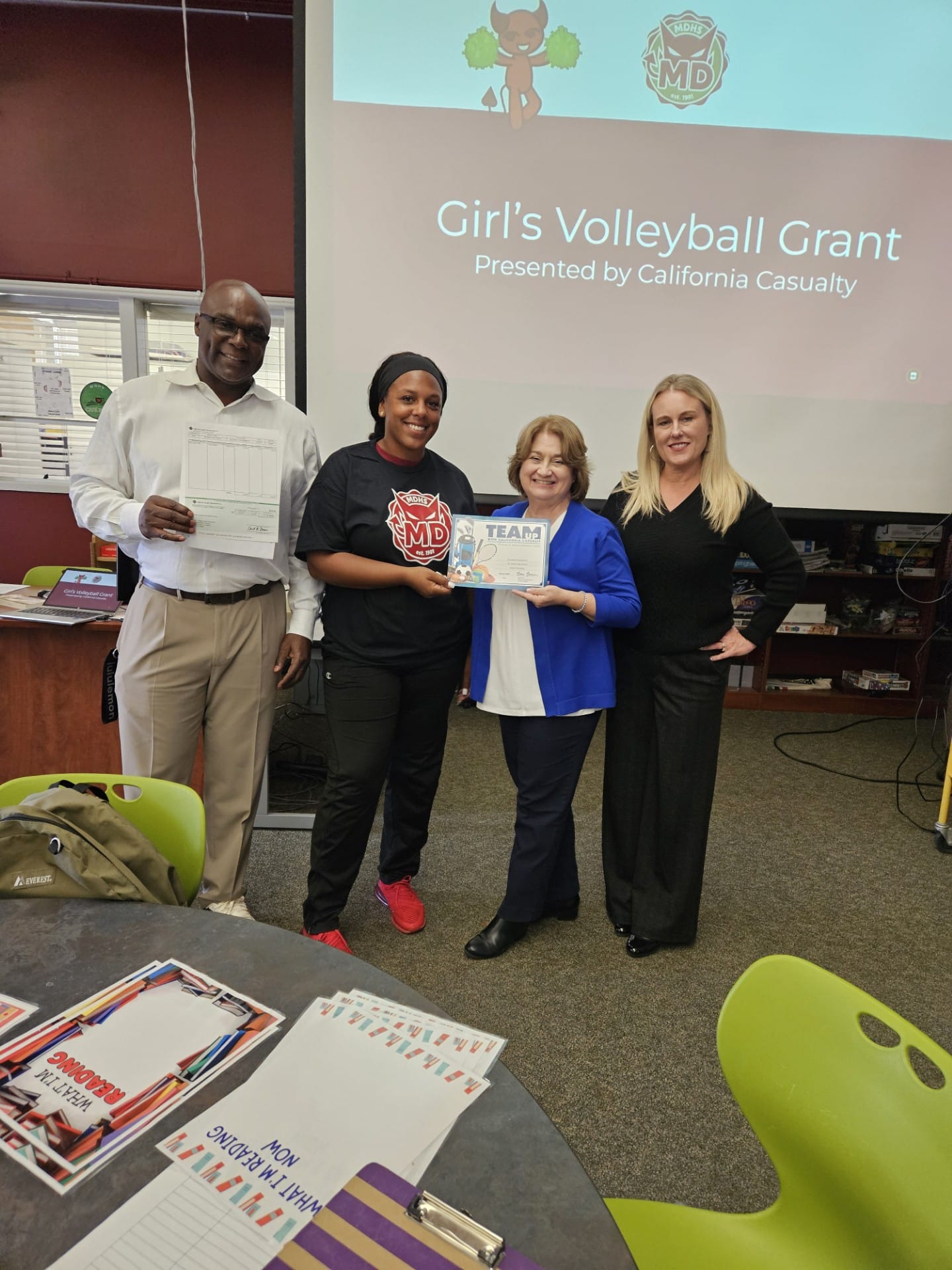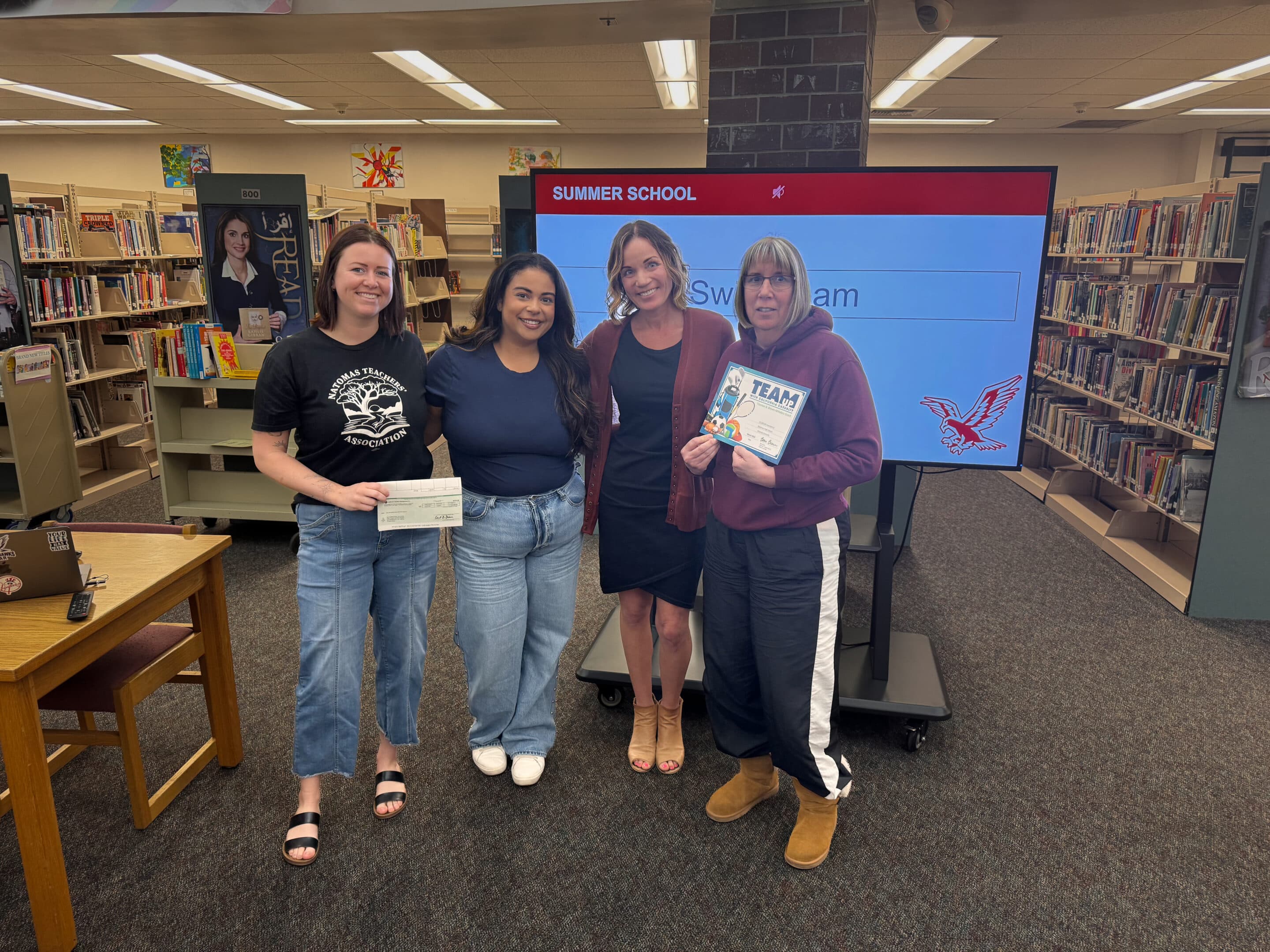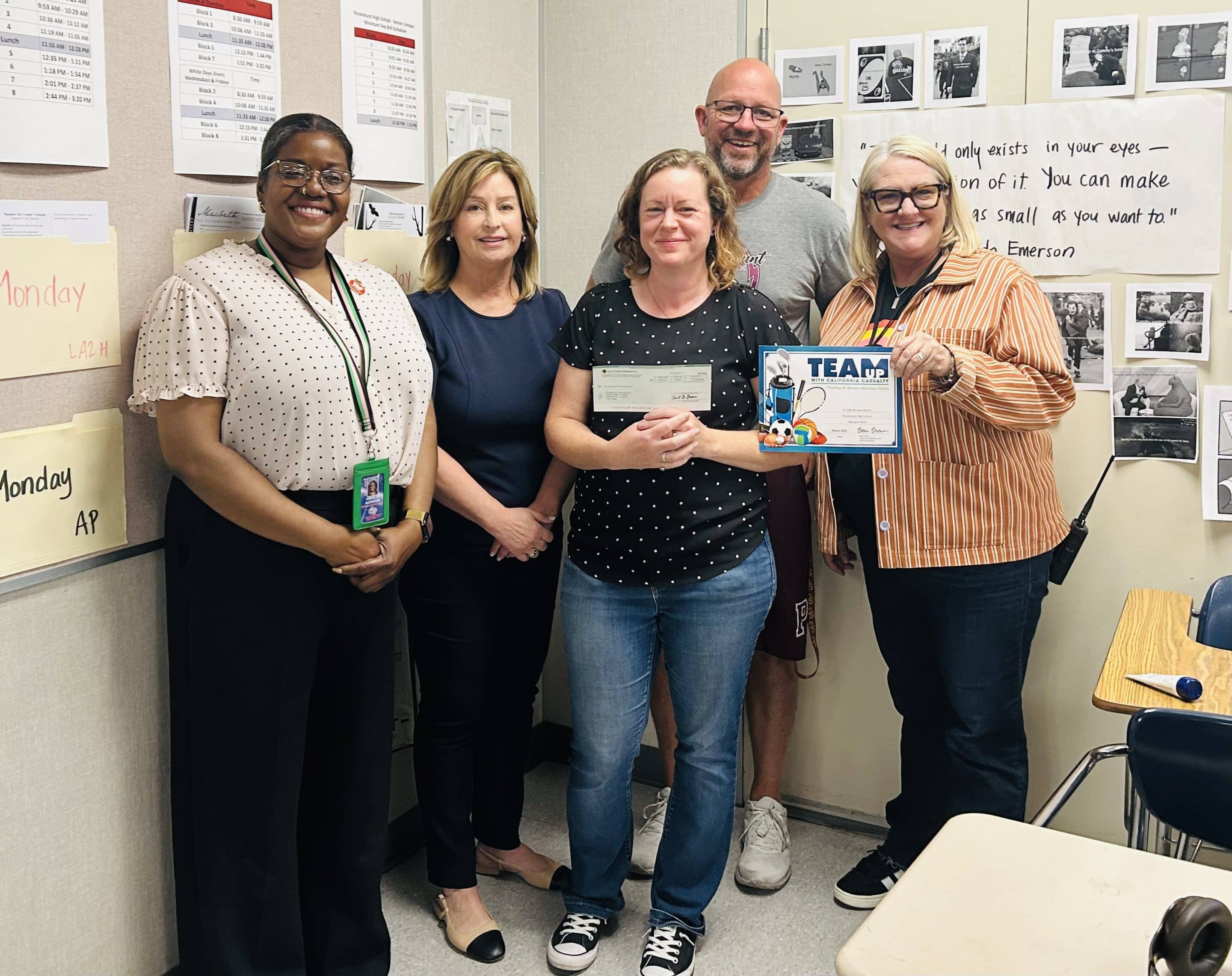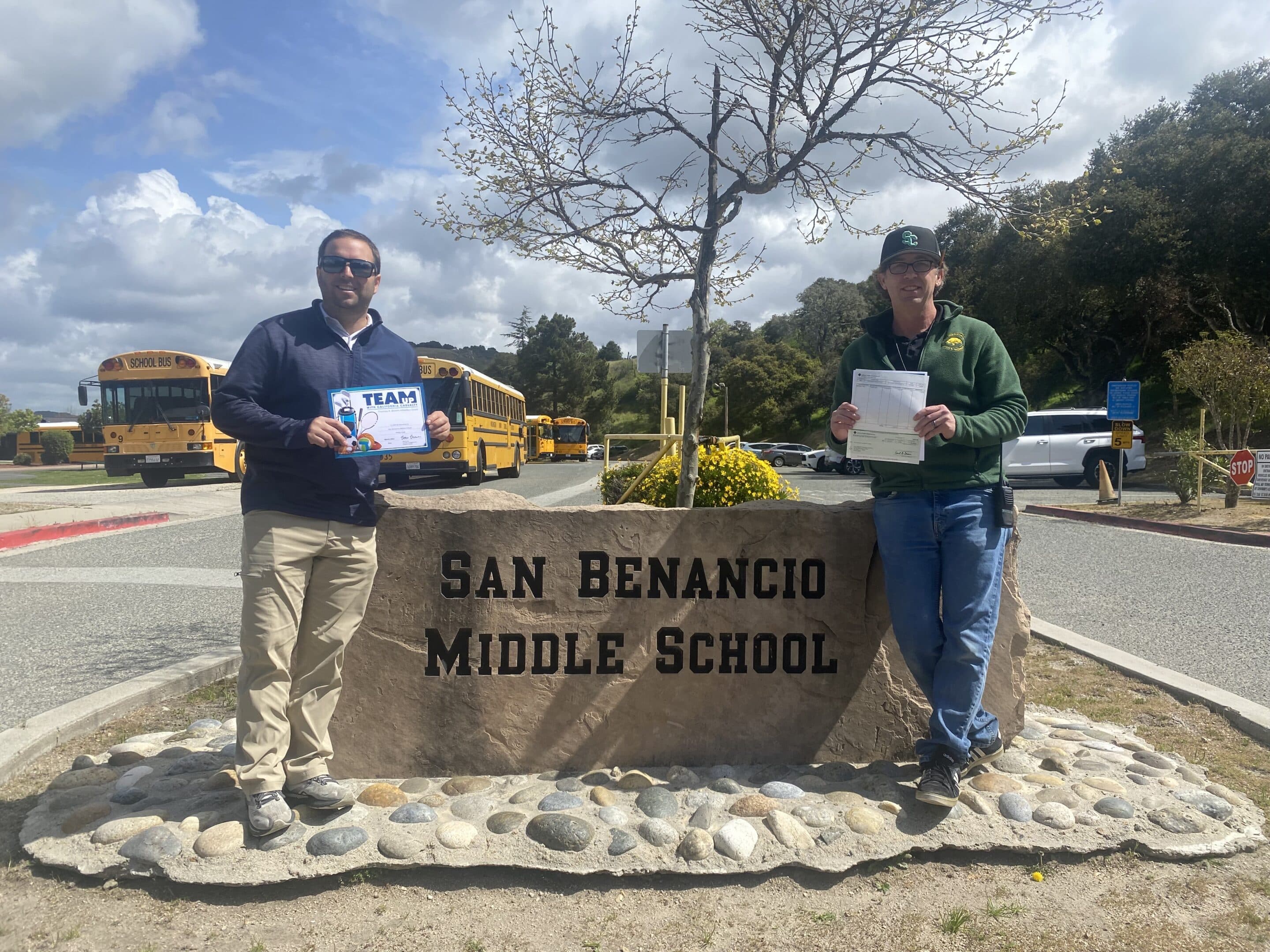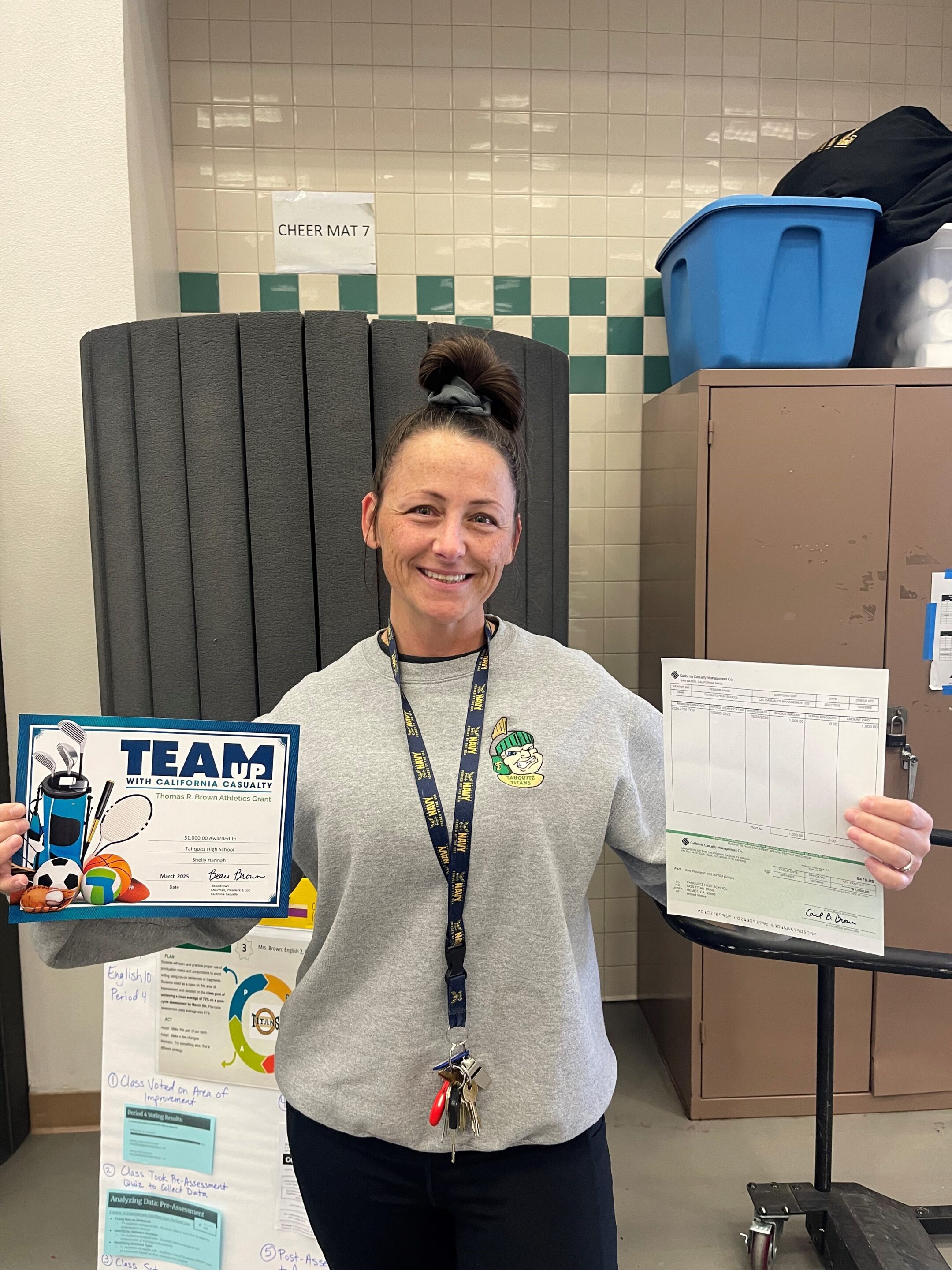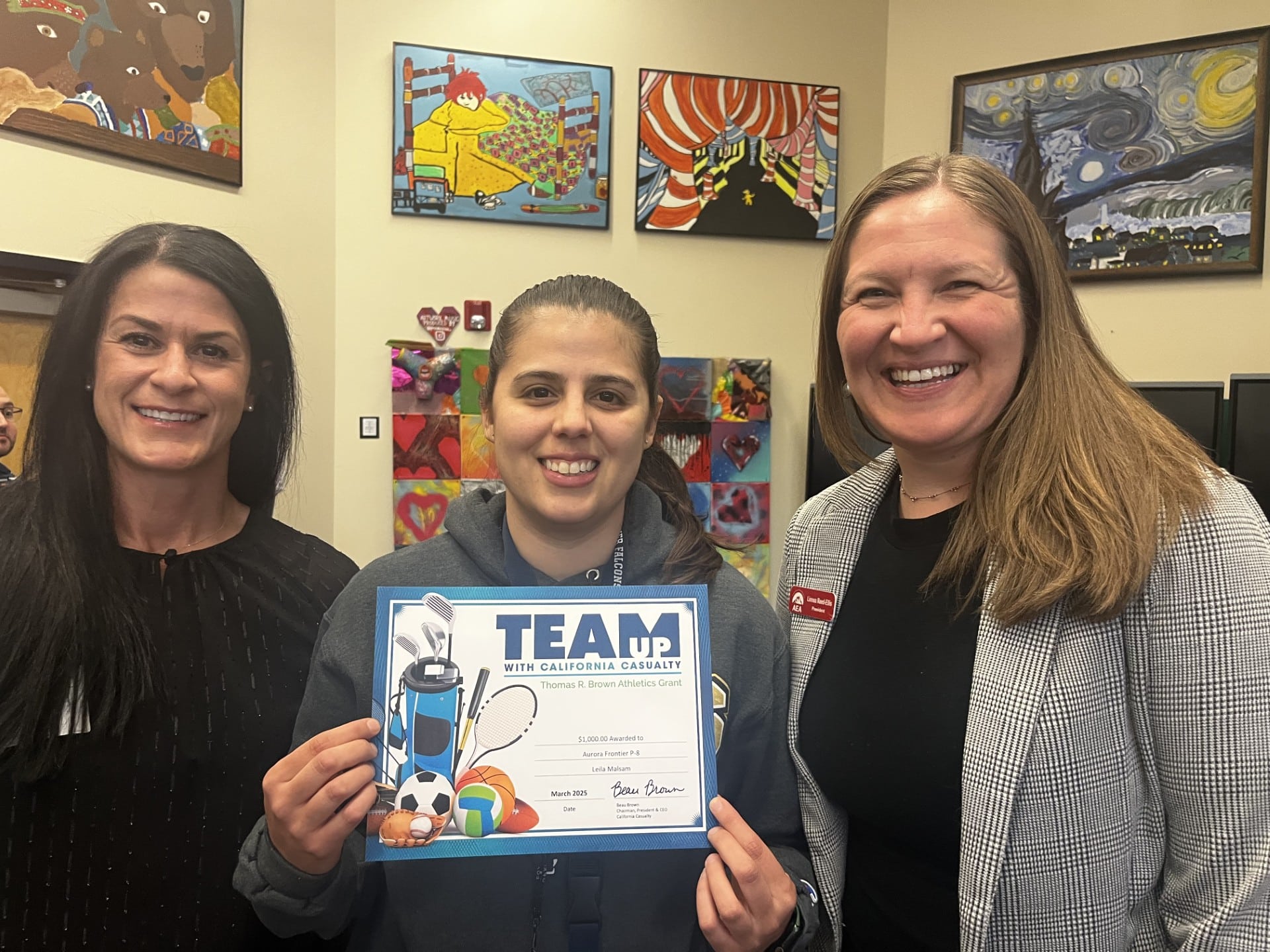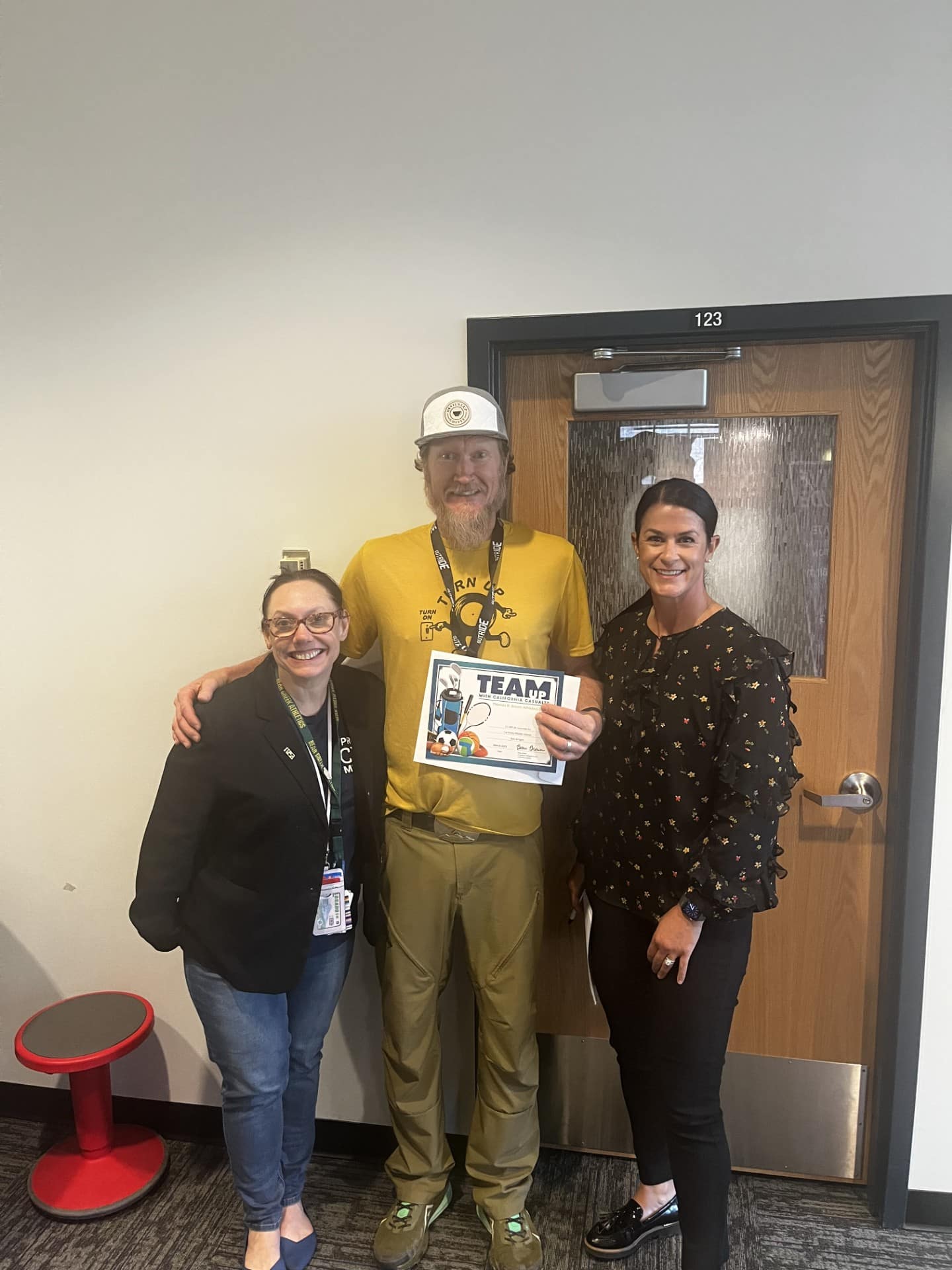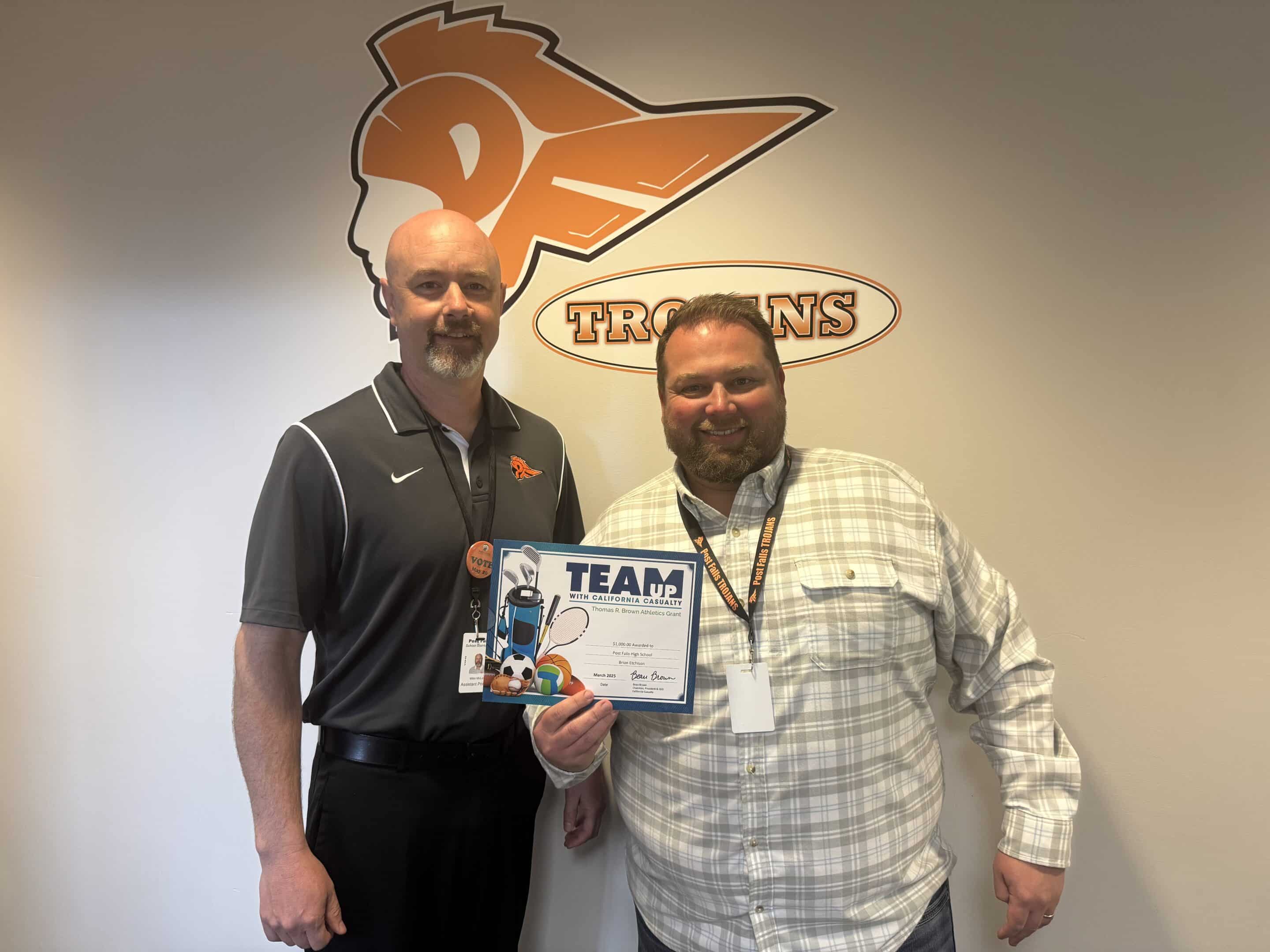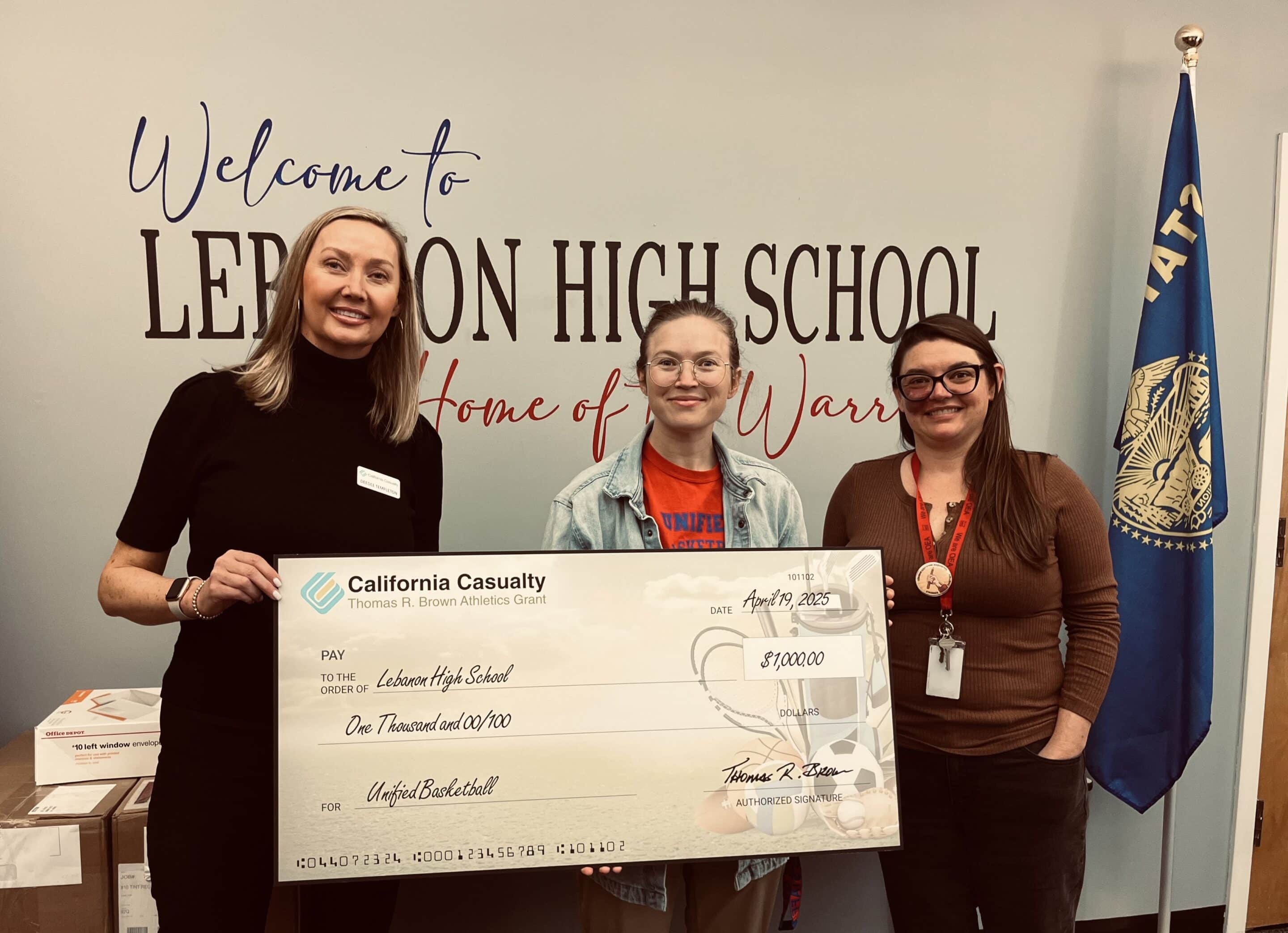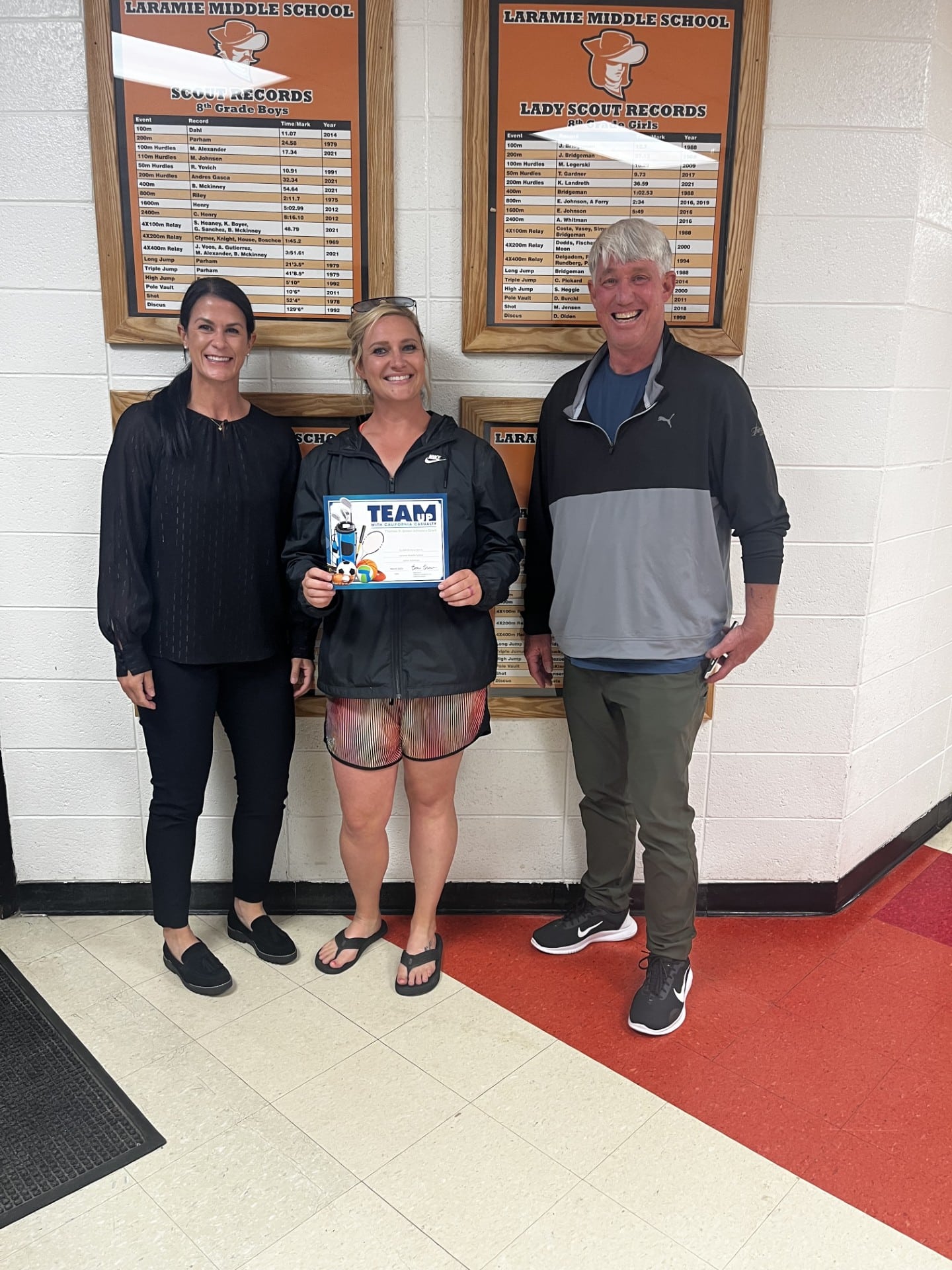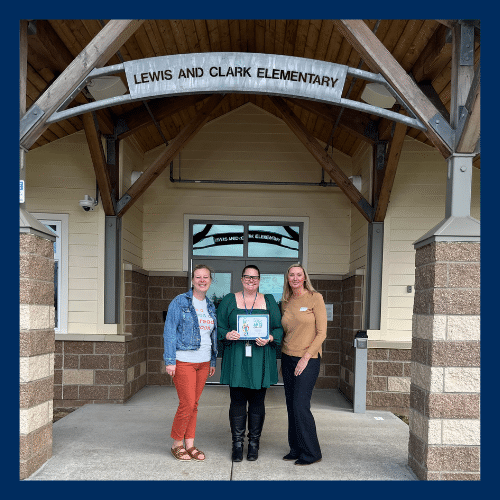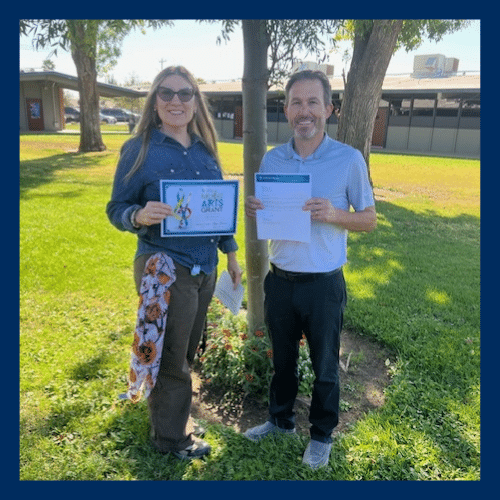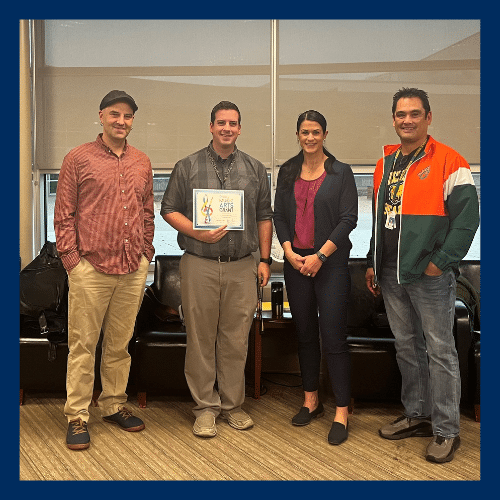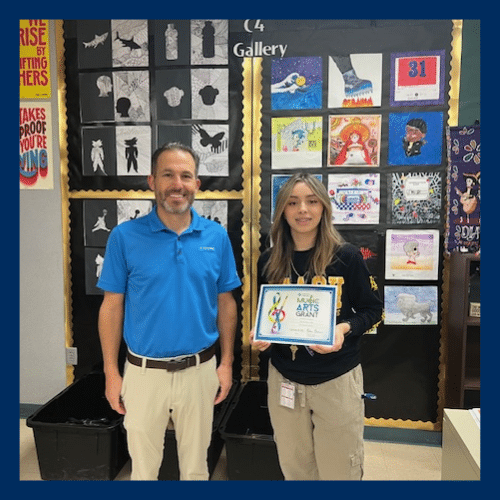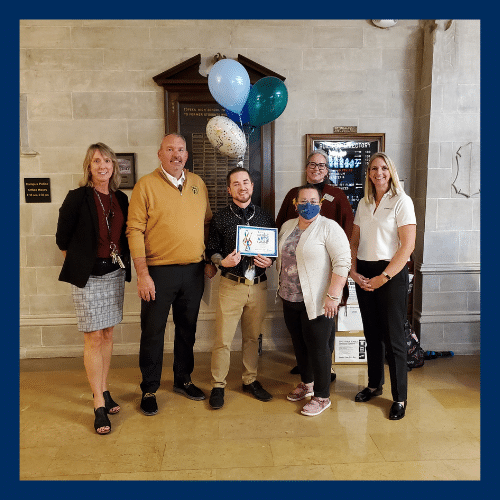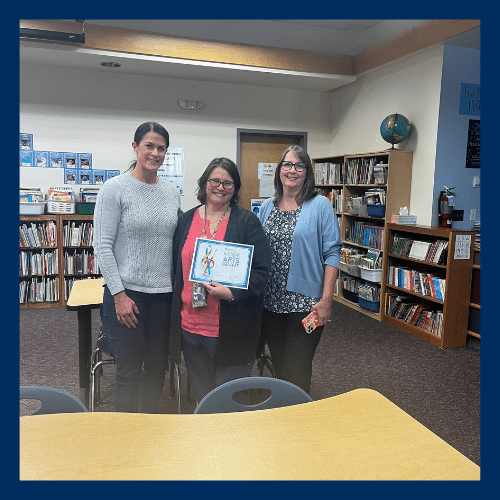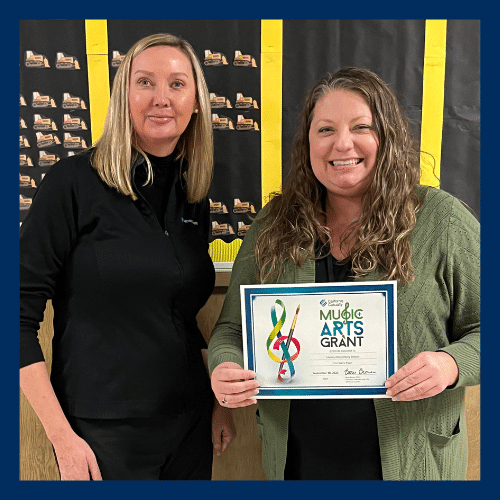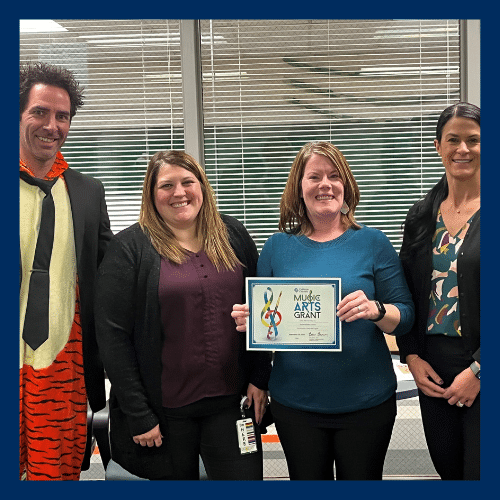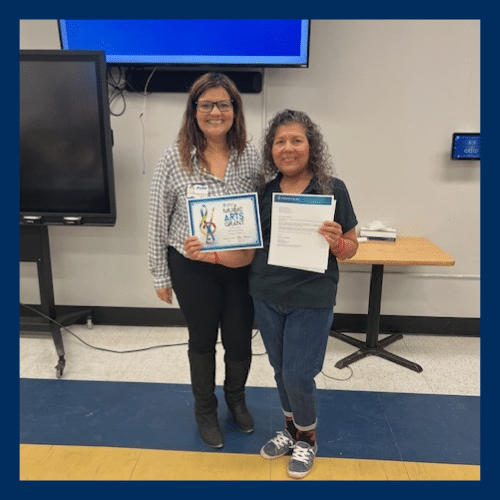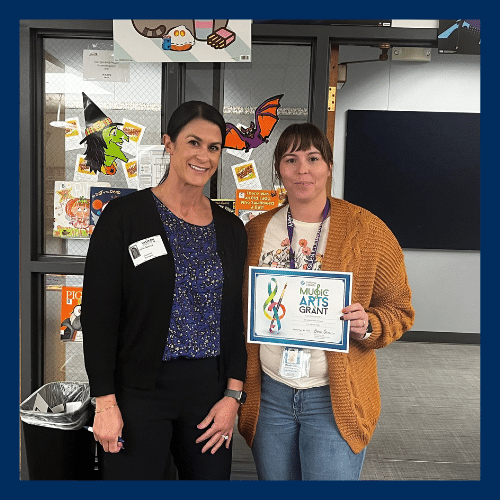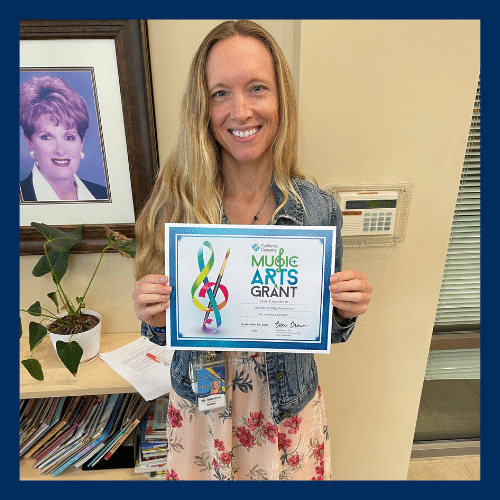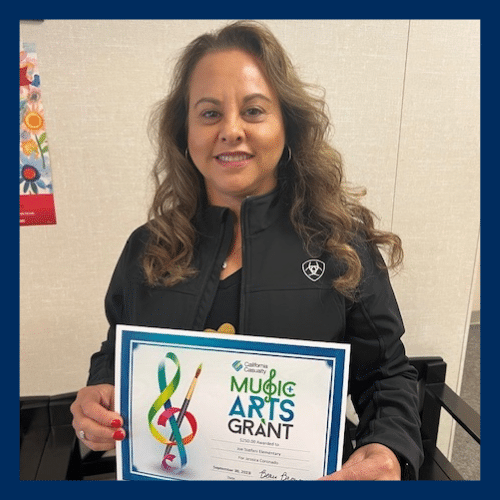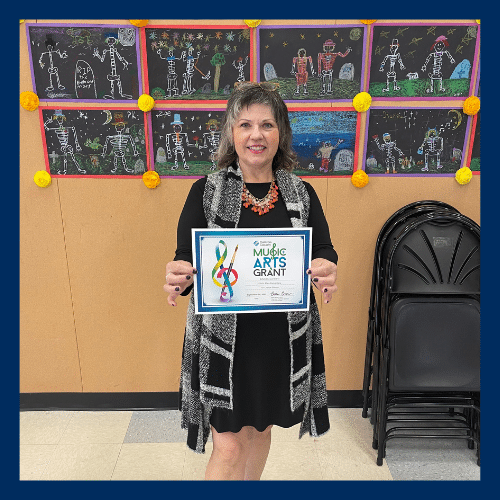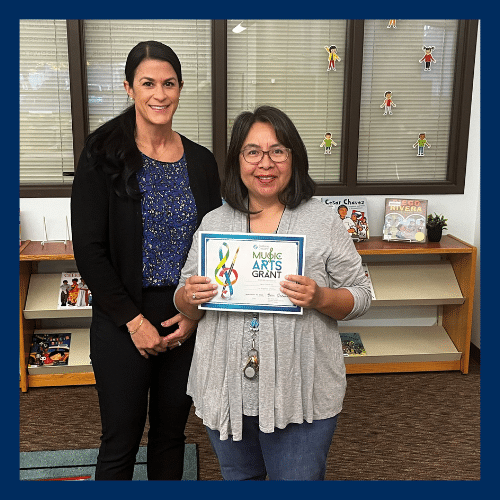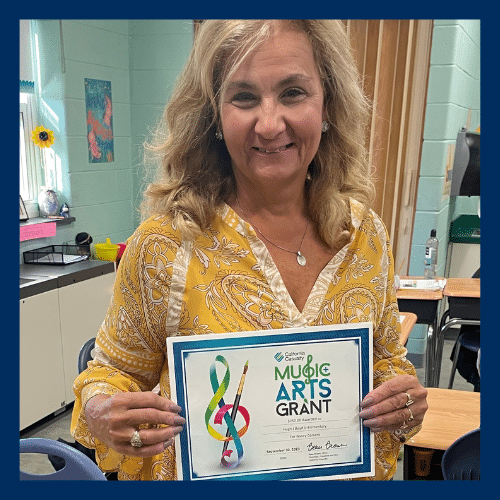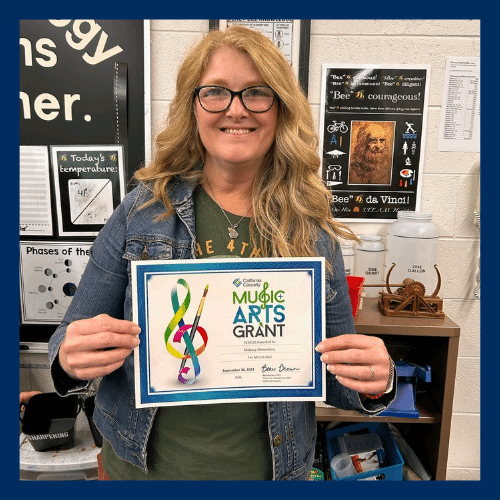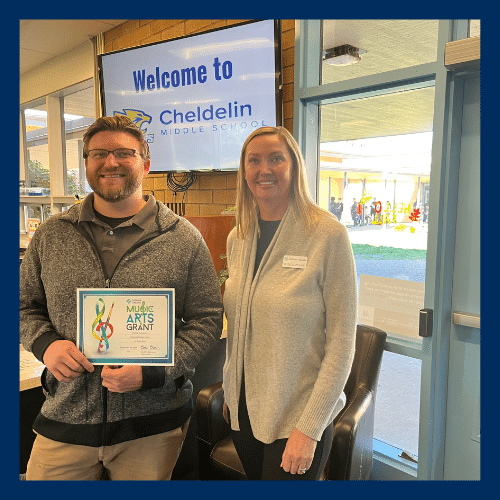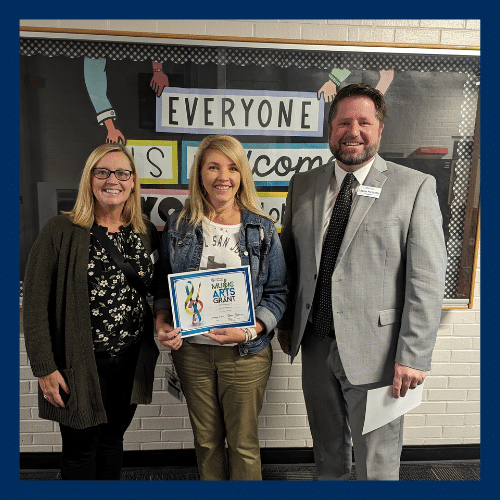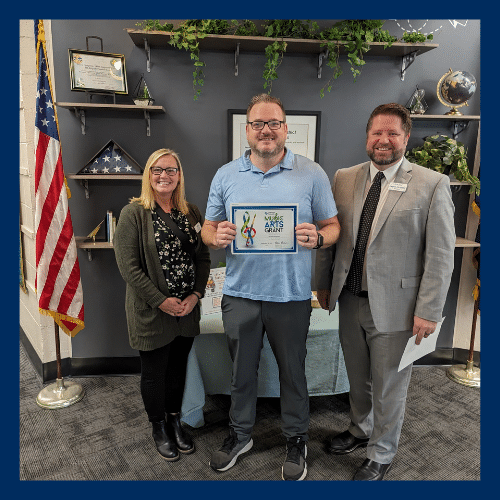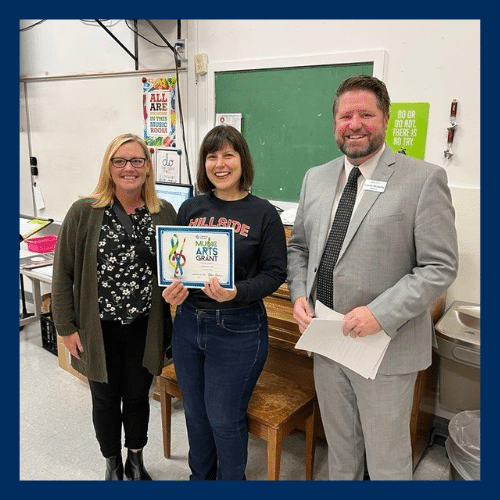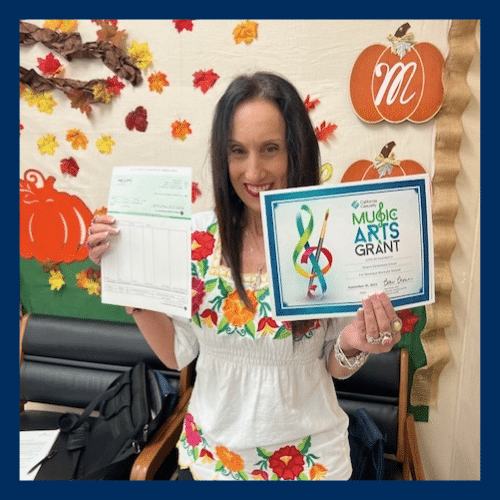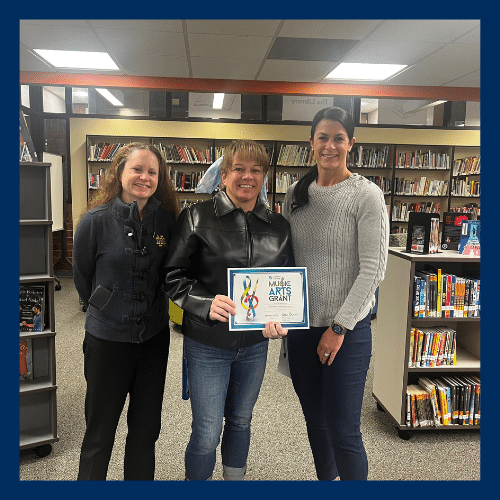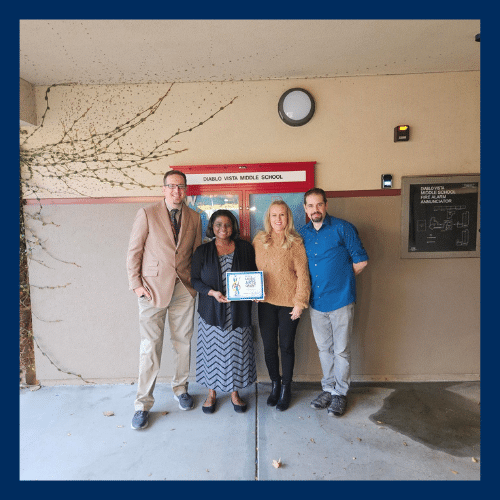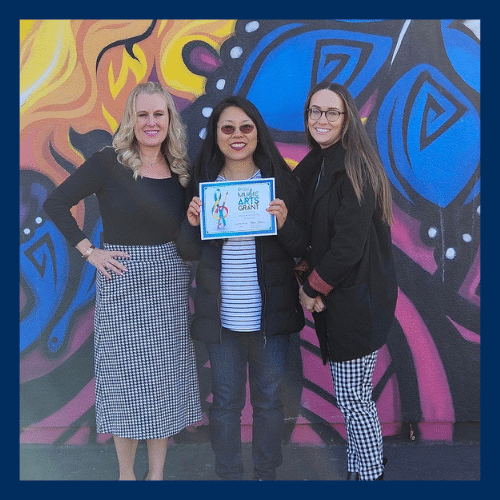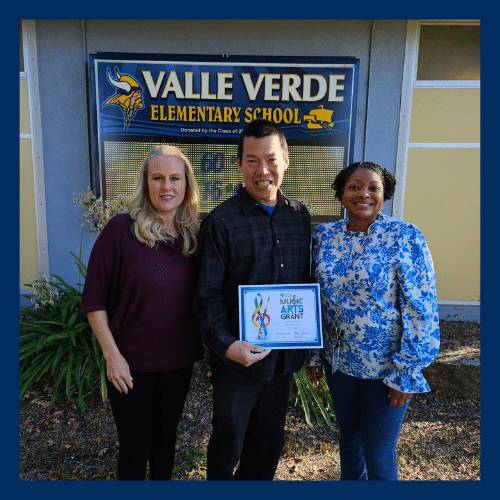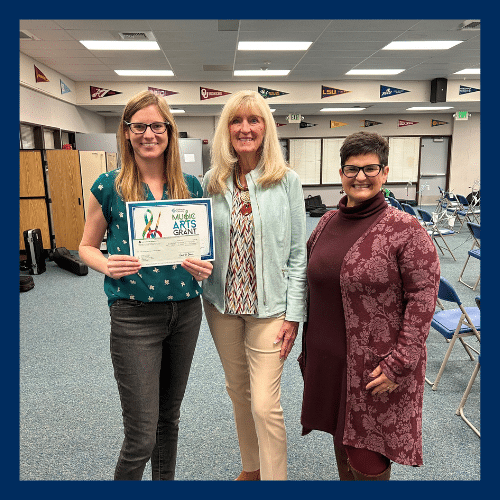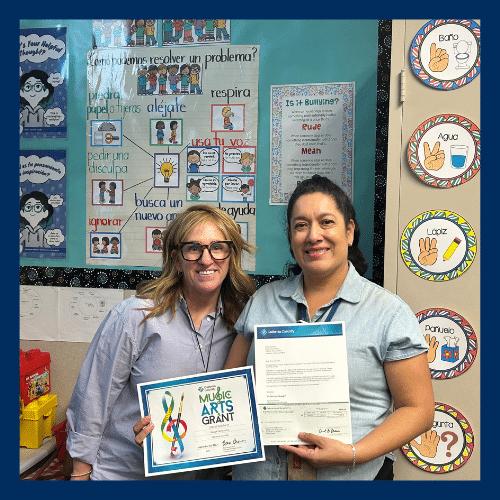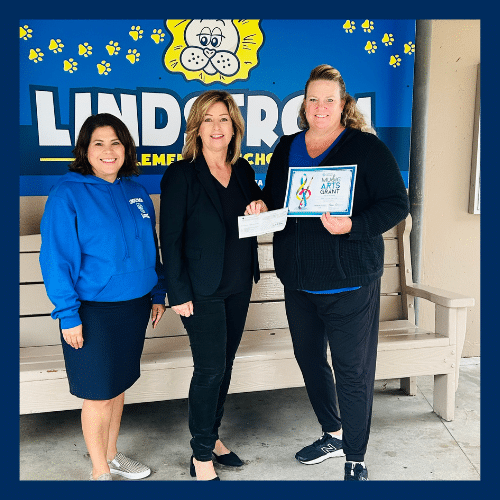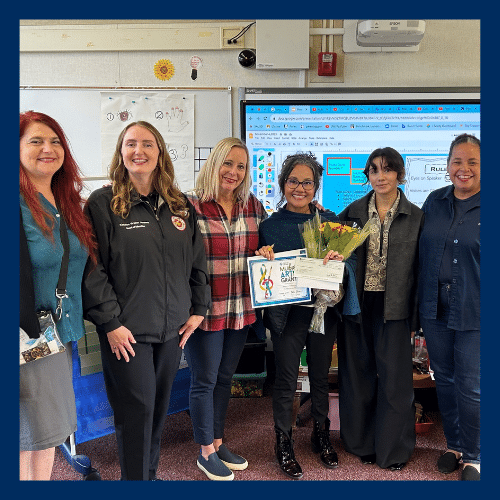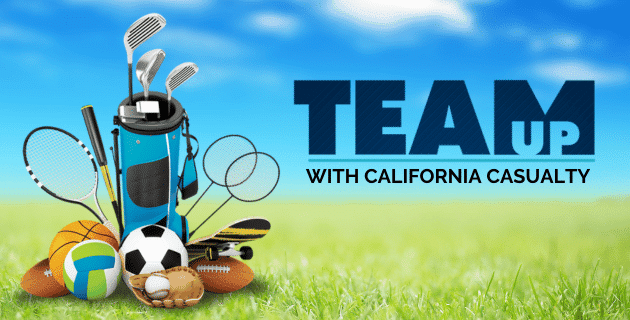
by California Casualty | Educators, In Your Community, News |
California Casualty has delivered $1,000 Thomas R. Brown Athletic Grants to educators at 10 public middle and high schools across five states to help support their school sports program(s). Since its inception in 2010, the Thomas R. Brown Athletics Grant Program has helped fund burdened athletic programs in 773 public schools across the nation.
Named in honor of Tom Brown, an ardent sports enthusiast and California Casualty Chairman Emeritus, the Thomas R. Brown Athletic Grant reflects his conviction that the values cultivated on the field—such as teamwork, trust, communication, and confidence—extend far beyond sports, enriching academic and personal development. Athletic programs play a pivotal role in shaping students’ character, fostering well-rounded individuals who excel both in the classroom and in life.
California Casualty recognizes the vital role of youth sports in promoting children’s physical and mental well-being. We are delighted to announce that the 2024/2025 Athletic Grants will support the following initiatives:
-
- Diablo High School – Concord, California – Girls Volleyball
- Natomas High School – Sacramento, California – Swim Team
- Paramount High School – Paramount, California – Girls Flag Football
- San Benancio Middle School – Salinas, California – Wrestling and Soccer
- Tahquitz High School – Hemet, California – Cross Country
- Aurora Frontier P-8 – Aurora, Colorado – Boys & Girls Basketball
- Carmody Middle School – Lakewood, Colorado – Carmody Bike Club
- Post Falls High School – Post Falls, Idaho – Track and Field
- Lebanon High School – Lebanon, Oregon – Unified Basketball
- Laramie Middle School – Laramie, Wyoming – Middle School Athletic Programs
Congratulations to all of our 2024/2025 grant recipients!
Mt. Diablo High School, Concord, CA
Applicant: Taylor Thompson
Athletic Program: Girls Volleyball
Photo L-R: Principal, Dr. Markell McCain, Recipient, Taylor Thompson, Mt Diablo EA President, Linda Ortega, and Angie Rajczyk
Natomas High School, Sacramento, CA
Applicant: Amanda Connelly
Athletic Program: Swim Team
Photo L-R: Swim Coaches, Eliana & Danielle, Amanda Keidel, Recipient, Amanda Connelly
Paramount High School, Paramount, CA
Applicant: Monique Reed
Athletic Program: Girls Flag Football
Photo L-R: TAP president, (DeeDee) Ardelia Aldridge, PE Coach, Frank Bignami, Flag Football Coach, Monique Reed and school principal, Jill Hammond.
San Benancio Middle School, Salinas, CA
Applicant: Phillip Snell
Athletic Program: Wrestling and Soccer
Photo L-R: Principal, Joe Carnazzo, Recipient, Phillip Snell
School: Tahquitz High School, Hemet, CA
Applicant: Shelly Hannah
Athletic Program: Cross Country
Photo: Recipient, Shelly Hannah
Aurora Frontier P-8, Aurora, CO
Applicant: Leila Malsam
Athletic Program: Boys & Girls Basketball
Photo L-R: Jolie Spence, Recipient, Leila Malsam and AEA President, Linnea Reed-Ellis
Carmody Middle School, Lakewood, CO
Applicant: Rob Wright
Athletic Program: Carmody Bike Club
Photo L-R: CEA Executive Committee and JCEA Secretary, Ang Anderson, Recipient, Rob Wright, and Jolie Spence
Post Falls High School, Post Falls, ID
Applicant: Brian Etchison
Athletic Program: Track and Field
Photo L-R: Assistant Principal, Mike Mclean and Recipient, Brian Etchison
Lebanon High School, Lebanon, OR
Applicant: Sheridan Echternach
Athletic Program: Unified Basketball
Photo L-R: Dee Dee Templeton, Recipient, Sheridan Echternach and Lebanon EA President, Bonita Randklev
Laramie Middle School, Laramie, WY
Applicant: Jamie Simmons
Athletic Program: Middle School Athletic Programs
Photo L-R: Jolie Spence, Jamie Simmons and Greg Herold (Uniserv Director)
by California Casualty | Educators, In Your Community, News |
Congratulations to all of the recipients of the 2024 California Casualty Music & Arts Grants! Our field team had the privilege to connect both in-person and virtually with many of the grant recipients to present them with a check for $250 to put towards supporting their schools’ music or arts program.
Check out the awardee spotlights and see the full list of recipients below.
Hannah Hurst – 2024 Music & Arts Grant Awardee Spotlight

Deerfield Elementary School, Lawrence, Kansas
Hannah Hurst, Kansas National Education Association Member
Deerfield Elementary Art Program
Hannah Hurst, art teacher and Kansas National Education Association Member, applied for a Music & Arts Grant to request funding for the Deerfield Elementary Art Program. Deerfield Elementary School is within the Lawrence Public Schools in Lawrence, Kansas and is considered a Title 1 school, with 28% of the student population considered economically disadvantaged.
Hannah wrote in her application, “My elementary art program lost 20% of its funding last school year due to a district wide budget crisis. Our budget now only allocates $3.00 per student for art supplies. This grant would help purchase consumable supplies for over 500 students.”
Jolie Spence, Sr. Account Development Manager with California Casualty, located in the greater Denver area, presented Hannah with the grant during a staff meeting via Zoom. Hannah remarked after receiving the grant “I am just thrilled to be able to provide my students with the supplies they need to have the very best art education!”
Photo: Hannah Hurst, Awardee
Molly Curro – 2024 Music & Arts Grant Awardee Spotlight

Columbian Elementary School
Molly Curro, Colorado Education Association Member
Columbian Elementary Art Program
Molly Curro, music teacher and Colorado Education Association member, heard about the Music & Arts Grant from her local union, Pueblo Education Association (PEA). She knew that her school Columbian Elementary, located in a high poverty community, would greatly benefit from the grant.
Molly wrote in her application that the grant would go towards a Piano Lab that would enhance music education through hands-on learning, promote creativity and collaboration among students and in turn enrich the school’s overall arts program.
Jolie Spence, Sr. Account Development Manager with California Casualty located in the greater Denver area, was excited to award this grant to Molly and Columbian Elementary. She along with Mike Maes (PEA President), Justina Carter (PEA Vice President), Jimmie Pool, Columbian Elementary Principal and colleagues presented the grant to Molly.
Photo L-R: Jimmie Pool, Columbian Elementary Principal, Molly Curro, Awardee, Mike Maes, Pueblo Education Association President, Jolie Spence, Sr. Account Development Manager
Kendall Wightman – 2024 Music & Arts Grant Awardee Spotlight
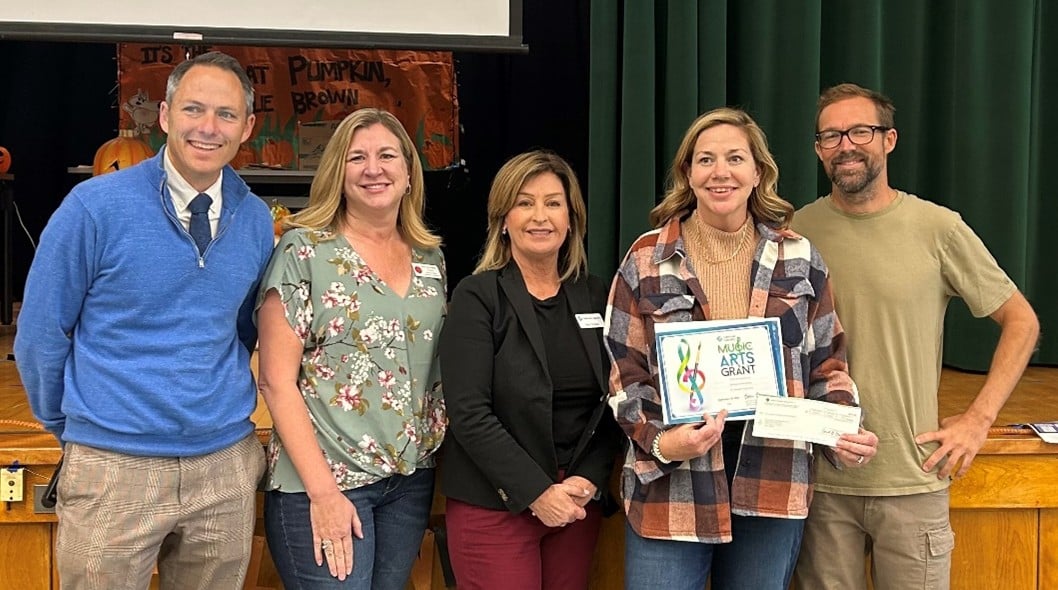
Elmhurst Elementary School, Ventura, California
Kendall Wightman, Teacher and California Teachers Association Member
Elmhurst Elementary Art Program
Kendall Wightman, Art Teacher and California Teachers Association Member, heard about the California Casualty Music and Arts Grant from her local union representative. Kendall shared in her application, “with budget cuts over the years, the school no longer receives the simplest of materials such as Sharpie markers for our students.”
Jana Charles, Sr. Account Development Manager, working located in the Southern California Los Angeles area, along with the Music & Arts Grant committee selected Kendall’s application to receive. Jana was due to surprise Kendall with the grant, however plans changed, “this was my most unforgettable presentation. On November 6th while in route to Elmhurst ES, I received a call from the school secretary advising me to turn back immediately, as schools across the district were dismissing staff and shutting down operations due to the wildfires in Ventura County. Despite the chaos, one week later I had the privilege of attending their November 13th staff meeting to surprise CTA member, Kendal Wightman, with the grant. This group was the most humble and enthusiastic group of individuals.” Although the Mountain Fire was destructive, burning over 20,000 acres, damaging and destroying hundreds of building, luckily few individuals were injured.
Photo L-R: Bret Klopfenstein, Principal (and happy CalCas customer), Sarah McLaughlin, President of Ventura Unified Education Association (another happy CalCas customer), Jana Charles, Kendall Wightman, Awardee, and Ryan Oast, Ventura Unified Education Association site representative
Katrina Snow – 2024 Music & Arts Grant Awardee Spotlight
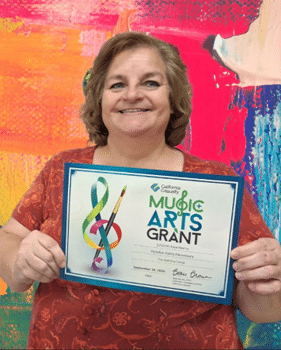
Paradise Valley Elementary, Casper, Wyoming
Katrina Snow, Art Teacher and Wyoming Education Association Member
Paradise Valley Elementary Lunar New Year Program
Paradise Elementary School in Casper, Wyoming services a dual language student population of both Mandarin Chinese and English. Each year the art, music and physical education teachers fund and host an all-school student art show that centers around the Zodiac animal of the Lunar New Year.
Katrina Snow, Art Teacher and Wyoming Education Association member, was excited to learn about the grant, writing that if awarded a grant, funds would go to props, costumes and other supplies so each student could make at least 2 projects to celebrate the Lunar New Year’s Year of the Snake.
Jolie Spence, Sr. Account Development Manager located in the greater Denver area, notified Katrina of the grant awardee. Jolie received a note from Katrina stating, “we are very excited to use these funds to enhance our all-school Lunar New Year Celebration taking place on January 31, 2025. The funds will be used well for the art show and performance by all of our talented students. Thank you for this opportunity!”
Photo: Katrina Snow, Awardee
Blake Kuroiwa – 2024 Music & Arts Grant Awardee Spotlight
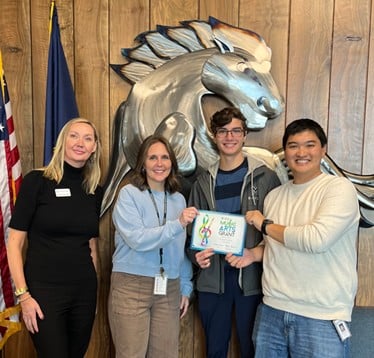
Mountainside High School, Beaverton, Oregon
Blake Kuroiwa, Oregon Education Association Member
Mountainside Band Program
Blake Kuroiwa, Band Instructor, Teacher and Oregon Education Association member, applied with a note stating that the band budget had been reduced by half this year due to cuts. This has reduced the program’s ability to serve students of lower socio-economic status. The funds from the grant will aid those students who wish to participate in marching band, winter guard, or winter percussion.
Dee Dee Templeton, Sr. Account Development Manager working locally in Oregon, presented to Blake along with the Band Booster President, Stephanie Marr. Dee Dee remarked that Blake was excited and thankful to receive the grant. He told Dee Dee that he spends his summer break looking for opportunities to raise funds and to find grants.
Photo L-R: Dee Dee Templeton, California Casualty Sr. Account Development Manager, Stephanie Marr, Band Booster President, Band member, Dani Castaneda, band member and Blake Kuroiwa, Awardee
Jim Phillips – 2024 Music & Arts Grant Awardee Spotlight
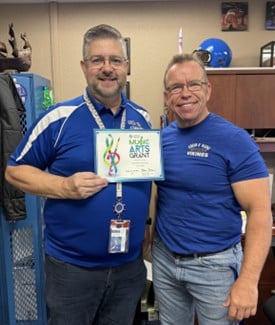
Coeur d’Alene High School, Coeur d’Alene, Idaho
Jim Phillips, Instrumental Music Director and Idaho Education Association Member
Coeur d’Alene High School Orchestra Program
Coeur d’Alene High School receives a Music & Arts Grant to help keep the music going. Located seven hours north of Boise is Coeur d’Alene High School in Coeur d’Alene, Idaho. The area is known for being the playground of the Pacific Northwest because of the many recreational activities. But for the orchestra department at the high school, budget cuts were impacting students’ ability to continuously play.
Jim Phillips, Instrumental Music Director and teacher at Coeur d’Alene High School wrote in his application that the orchestra has not had a budget for about five years. If a string breaks in rehearsal, the instrument and the player are out of commission until a new string can be acquired.
Dee Dee Templeton, Sr. Account Development Manager working locally in Oregon, shared the goods news with Jim about his application being selected for a Music & Arts Grant. Dee Dee shared that Jim was so thankful for the grant award, that being able to have new strings readily available is such a basic need.
Photo L-R: Jim Phillips, Awardee, and Mike Randles, Coeur D’Alene High School Principal
Melanie Tanesco – 2024 Music & Arts Grant Awardee Spotlight

J.C. Crumpton Elementary School, Marina, California
Melanie Tanesco, 1st Grade/Special Education Teacher and California Teachers Association Member
J.C. Crumpton Elementary Saturday Academy – Inclusive Program
Melanie Tanesco, 1st Grade/Special Education Teacher and California Teachers Association member, heard about the California Casualty Music & Arts Grant from her local union newsletter. She knew the J.C. Crumpton Elementary Saturday Academy program would benefit from the grant.
Melanie wrote in her application that the program includes painting, STEAM art challenges and other inclusive programs attended by both general and special education students. “The grant will ensure that all students continue to benefit from these enriching experiences, helping our kids to be creative and embrace their unique talents. Despite potential budget constraints, the focus will be on maintaining the quality and accessibility of our inclusive Saturday Academy to support the diverse needs of our student community and foster a love for creativity and learning.”
Chris Nieto, Account Development Manager located in central California, delivered the good news to Melanie. Chris said that “Melanie was very excited and thankful to be chosen as one of this year’s recipients of the California Casualty Music & Arts Grant. She plans to use the funds for a variety of art projects.”
Photo: Melanie Tanesco, Awardee, and Chris Nieto, Account Development Manager
Brian Mabry – 2024 Music & Arts Grant Awardee Spotlight
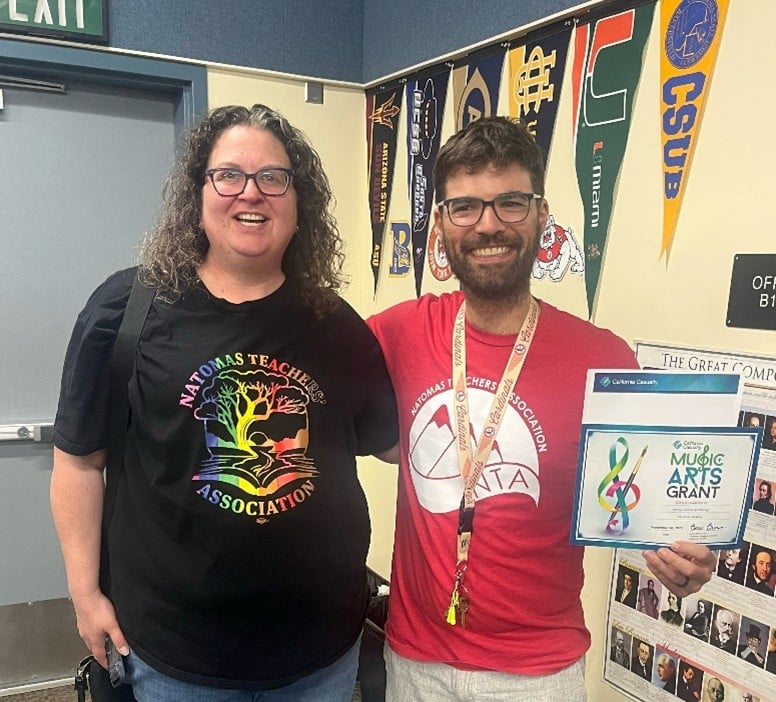
Leroy Greene Academy, Sacramento, California
Brian Mabry, Music Teacher and California Teachers Association Member
Leroy Greene Academy Band
Brian Mabry, Music Teacher at Leroy Greene Academy was in the middle of updating his California Casualty Insurance policy when he was surprised by Amanda Keidel, Account Development Manager covering accounts in northern California, and Mara Harvey, Natomas Teachers’ Association President. They were there to deliver a $250 Music & Arts Grant award to Brian.
In the application, Brian wrote, “the LGA music program has suffered for the past several years due to lack of staffing. Previously it offered classes for junior high and high school students with two different teachers. Last year they could not find a teacher; the music class was transformed into a computer course. In my first year, I started a band program and have almost 200 students.”
Amanda said that Brian was very surprised and thrilled; he plans to purchase sheet music and reeds for his classes.
Photo L-R: Brian Mabry, Awardee and Mara Harvey, Natomas Teachers’ Association President
Rhonda McQuown – 2024 Music & Arts Grant Awardee Spotlight
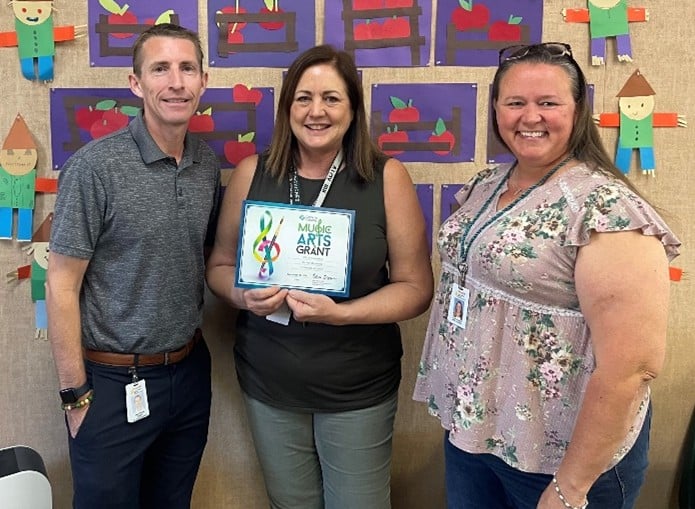
Rio Vista Elementary, Cathedral City, California
Rhonda McQuown, Special Education Teacher and California Teachers Association Member
Special Education – Special Day Class
Rhonda McQuown, Special Education Teacher and California Teachers Association member, was surprised this fall with a $250 Music & Arts Grant from California Casualty.
Rhonda wrote in her application that she was requesting funding to purchase art supplies that are appropriate for her special education classroom of mild/moderate students that have learning disabilities, autism or intellectual disabilities, stating “appropriate art supplies will enhance student enrichment and art experiences.”
Inez Morales, Sr. Account Development Manager, located in southern California, had the pleasure of surprising Rhonda with the grant award. She along with the Principal, Vice Principal of Rio Vista Elementary, the Palm Springs Teachers Association President and fellow colleagues celebrated Rhoda and her students. Inez remarked, “Rhonda helps her students reach their full potential, offering not just academic instruction but also emotional support, advocacy, and life skills development. The way her students interacted with her spoke volumes about how special she is, there were smiles all around that day.”
Photo L-R: Aaron Tarzian, Rio Vista Elementary Principal, Rhonda McQuown, Awardee, Karen Johnson, Palm Springs Teachers Association President
Inez Rowles – 2024 Music & Arts Grant Awardee Spotlight

New Hope Elementary, Thornton, California
Inez Rowles, Teacher, New Hope Education Association President and California Teachers Association Member
Art in the Classroom
Inez Rowles, kindergarten teacher, New Hope Education Association President and California Teachers Association Member, at New Hope Elementary heard about the Music & Arts Grant from Angie Rajczyk, Account Development Manager covering accounts in the San Francisco Bay Area. New Hope Elementary is a one-building school district in a very rural area, with limited resources. Inez applied asking to support art education for the students in her classroom.
Angie along with New Hope Elementary Principal, Clint Johnson, presented the grant to Inez. Inez told Angie that ” I am so excited for the grant. I am going to use the funds to purchase portfolios and art supplies for all the students. This will allow them to keep all of their artwork in one place and be able to showcase it at the end of the year.”
Not only is Inez the local president of New Hope Education Association, the Principal, Clint, is an ACSA member!
Photo L-R: Inez Rowles, Awardee, Angie Rajczyk, Account Development Manager and Cliff Johnson, New Hope Elementary Principal
Amy Kirchoff – 2024 Music & Arts Grant Awardee Spotlight

Richardson Elementary School, Tucson, AZ
Amy Kirchoff, Music Teacher and Arizona Education Association Member
Richardson Elementary Music Program
Amy Kirchoff, music teacher and Arizona Education Association member, has felt the pressure of budget cuts. With an idea to broaden her students’ horizons through music she looked to the California Casualty Music & Arts Grant as a solution. Amy wrote if awarded, “the grant money will be used to purchase multicultural instruments, games, and activities for her students.”
On the afternoon of October 30th, Amy was expecting a routine discussion with her school principal, Mr. Linker, to celebrate her recent achievements. He informed Amy that there would be more participants attending the meeting virtually. It was an exciting moment when Jana Charles, Sr. Account Development Manager and Paul Deutsch, Strategic Account Manager presented Amy with the grant, recognizing her hard work and dedication. Jana remarked that Amy’s reaction was priceless, making the surprise even more special.
Photo Top-Bottom: Amy Kirchoff, Awardee, Paul Deutsch, Strategic Account Manager, Jana Charles, Sr. Account Development Manager
The complete list of 2024 Grant recipients are:
- Danielle Yeti,A.M. Winn Elementary School , Sacramento , CA , Electives programs for grades 6-8
- Ashley Martinez , Anna McKenney Intermediate , Marysville , CA , Drama
- Joleen Vincent , Creative Connections Arts Academy High School , Sacramento , CA , Introduction to Art classes
- Joleen Vincent , Creative Connections Arts Academy High School , North Highlands , CA , Visual Arts
- Beth Geise , Hooker Oak Elementary School , Chico , CA , Alzheimers Care
- Brian Mabry , Leroy Greene Academy , Sacramento , CA , LGA Band
- Erica Hung , Riverview STEM Academy , Rancho Cordova , CA , Education through Music
- David Hunter , Bridge Program – Diablo Unified School District , Concord, CA , Visual Arts
- Jessica Gutierrez , James Lick High School , San Jose , CA , James Lick Advanced Art Pathway / Visual Arts Program
- Leslie McNabb , Lone Tree Elementary , Antioch , CA , Classroom
- Angela Ordaz , Mountain View Elementary , Concord , CA , School Counseling
- Inez Rowles , New Hope Elementary , Thornton , CA , Art in my classroom
- Crystal Latonio , Zane Middle School , Eureka , CA , Art Therapy
- Alexa Quezada , El Monte Middle School , Orosi , CA , Art Elective Classroom
- Lindsay Doyle , Fairmont Elementary , Sanger , CA , Art Show
- Melanie Tanseco , JC Crumpton Elementary , Marina , CA , TK – 6th
- Amber Wilkerson , Los Ranchos Elementary School , San Luis Obispo , CA , Special Education Day Classes
- Rebecca Townsend , Rivergold Elementary School , Coarsegold , CA , Classroom
- Janet Washington , Stella Hills Elementary , Bakersfield , CA , Art
- Jim Phillips , Coeur d’Alene High School , Coeur D Alene , ID , Orchestra
- Jessica Johnson , Hawthorne Middle School , Pocatello , ID , Hawthorne Middle School Choirs
- Melissa Syverson , Lewiston High School , Lewiston , ID , Drama Department
- Ainsley Boan , Whitney Elementary School , Boise , ID , Art
- Andrew Thompson , Aloha High School , Aloha , OR , Music Studio Program
- Jennifer Stone , Cedar Park Middle School , Porland , OR , Band
- Blake Kuroiwa , Mountainside High School , Beaverton , OR , Mountainside Band Program
- Brianna Carder , Talmadge Middle School , Independence , OR , Mariachi Program
- Chelice M Gilman , Ella B. Allen Elementary , Bonita , CA , Visual Art
- Lisa Sandberg , Gus Franklin Jr. STEM School , Victorville , CA , Art program
- Carolyn Quirino , La Granada Elementary , Riverside , CA , Art lessons for students through Art Smarts
- Natalee Boggs , Murrieta Mesa High School , Murrieta , CA , Special Education
- Natalee Boggs , Murrieta Mesa High School , Murrieta , CA , Unified Leadership
- David von Behren , Oasis Elementary School , Twentynine Palms , CA , Autism Music and Sculpture
- Rhonda McQuown , Rio Vista Elementary , Cathedral City , CA , Special Day Class
- Jean Tillman , Brookhurst Elementary School , Garden Grove , CA , Kindergarten Students
- Kristen Hellewell , Castille Elementary , Mission Viejo , CA , Special Needs in Music
- Roberto Ontiveros , Century High School , Santa Ana , CA , Century Instrumental Music Program
- Kendall Wightman , Elmhurst Elementary , Ventura , CA , Elementary Art
- Araceli Garcia , Workman High School , City of Industry , CA , ELD Design-Based Learning Summer program
- Jessica Reed , York Elementary , Hawthorne , CA , Painting
- Kirstin Miller , Bear Creek High School , Lakewood , CO , Bear Creek High School Instrumental Music Program
- Kathy Van Wert , Bill Reed Middle School , Loveland , CO , Bill Reed Middle School Band Program
- Molly Curro , Columbian Elementary , Pueblo , CO ,
- Cheryl Malet , Escalante-Biggs Academy , Denver , CO , Art
- Michele Arthur , Jack Swigert Middle School , CO Springs , CO , Art
- Amelia Haug , Maplewood Elementary , Greeley , CO , Music Classes and Choir Program
- Amy Holle , Niwot High School , Niwot , CO , Unified Theater
- Patricia Koed , Platte Valley Middle School , Kersey , CO , PVMS Choir
- Kari Dusenbery , York International , Thornton , CO , Middle/High School art and Design
- Hannah Hurst , Deerfield Elementary , Lawrence , KS , Deerfield Elementary Art Program
- Crystal Plante , Hill City Grade School , Hill City , KS , Art
- Katrina Snow , Paradise Valley Elementary , Casper , WY , Primarily Art-art and music programs works together to create a school-wide art show and performance.
- Lynnsey Patterson , Woods Learning Center , Casper , WY , Art
- Charla Jones , Carol G. Peck School , Glendale , AZ , K-8 art program
- Monika Beauvais Landi , Fulton Elementary School , Chandler , AZ , Fulton Elementary School General Music Program
- Gabriela Carrillo , Mitchell Elementary , Phoenix , AZ , Mitchell’s Art Program
- Christina Ozuna , Park Meadows Elementary , Glendale , AZ , Art
- Marguerite Samples , Pueblo Gardens PreK-8 School , Tucson , AZ , Art
- Graham Corp , Rhodes Jr. High School , Mesa , AZ , Special Education/Band
- Amy Kirchoff , Richardson Elementary , Tucson , AZ , Music
- Monica Tavcar , Sunrise Elementary School , Phoenix , AZ , Sunrise School Art Program
- Judith Arnold , Thomas Elementary School , Flagstaff , AZ , Native American education

by California Casualty | Auto Insurance Info, Calcas Connection, Finances, Helpful Tips, Homeowners Insurance Info |
We understand that changes to insurance premiums can be concerning, and we want to help you understand the factors that influence your rates. Insurance rates are determined by a combination of external conditions and personal policy coverage selections. Below, we’ll explain some of the most common reasons rates can increase and what changes in your policy could impact your premium.
External Factors That Can Cause Rate Increases
1. Rising Costs of Repairs and Replacements
For auto insurance, advanced technology in vehicles, like sensors and cameras, makes repairs more expensive. In the case of a total loss, rising prices for new and used vehicles drives up the cost of replacement. Similarly, home insurance is impacted by increasing prices for building materials and labor, making it more costly to repair or rebuild homes after a loss.
2. Weather and Natural Disasters
Severe weather events, such as wildfires, floods, and hailstorms, are happening more frequently and with greater intensity. These events lead to higher claim payouts and cause insurance rates to rise, even in areas that haven’t been directly affected.
3. Inflation
General inflation affects nearly every industry, including insurance. The rising cost of goods and services —from everything associated with a minor vehicle repair all the way to restoring extensive home damage, like parts, materials, labor, rental cars, temporary housing, legal and medical expenses —can result in an adjustment of premiums to align with the amount that is paid out on claims.
4. Increased Claim Frequency
More claims being filed—whether due to a rise in car accidents, litigation, or property damage—paired with increased claims costs can lead to paying out more on claims than what is collected in premium. When this happens, a rate increase can occur.
5. Reassessment of Risks
Insurance companies regularly re-evaluate risks in specific areas. If you live in a region that’s seen more accidents, theft, or natural disasters, your premiums may increase to reflect the heightened risk.
How Policy Changes or Adjustments Affect Your Premium
1. Adding or Removing Coverage
Expanding your coverage—such as adding comprehensive auto coverage or increasing your home insurance policy limits—will raise your premium. Conversely, reducing coverage may lower your rate but could leave you underinsured.
2. Adjusting Deductibles
Choosing a higher deductible typically lowers your premium since you agree to pay more out-of-pocket in the event of a claim. However, a lower deductible means your insurer covers more upfront, which increases your premium.
3. Policy Discounts and Loss of Discounts
We offer many discounts including affiliated group membership, bundling auto and home, multi-vehicle, safe driving, home security, non-smoking, good student, mature driver, etc. If you no longer qualify for a discount, your rate may increase.
4. Changes in Your Personal Profile
Life changes such as adding a new driver to your policy, changes to the number or type of covered vehicles, or moving to a different area can impact your premiums.
5. Claims History or Driving Record
Filing a claim can result in higher premiums at renewal. Additionally, if a ticket or accident is charged against your driving record, you may be subject to a surcharge that will likely raise your rates.
How You Can Help Manage Your Premiums
While some factors are out of your control, there are steps you can take to keep your premiums manageable:
- Bundle Policies: Combining your auto and home insurance or having multiple vehicles on one policy can help you save more.
- Review Your Coverage: Call us for a free policy review to make sure you’re not paying for coverage you don’t need.
- Increase Your Deductibles: Opting for a higher deductible can lower your premium but be prepared to cover more out-of-pocket costs in the event of a claim.
- Maintain a Safe Driving Record: Avoid accidents and traffic violations to keep your auto insurance costs down.
- Home Upgrades: A new roof, installing alarms, fire-resistive updates, or upgrading plumbing, electrical or HVAC systems can help you qualify for discounts.
- Ask About Discounts: Let us know if there have been changes, like completing a mature driving course, a child away at school without a vehicle, or reaching a milestone like retirement. We also offer discounts for multi-home, years claim free, good student, safe driving, and driver training for youthful drivers
We’re Here to Help
Whether it’s an auto accident or a home repair after a storm, having insurance helps ensure you’re not left to bear the full financial burden – so maintaining adequate coverage is crucial.
We understand that insurance can feel complex, but we’re here to make it simple and help make sure you have the coverage that’s right for you. Our trusted advisors are available to review your current policies, provide guidance on your coverage options, help explore ways to save, and answer any questions you have.
Thank you for trusting us to protect what matters most to you.
This article is furnished by California Casualty, providing auto and home insurance to educators, law enforcement officers, firefighters, and nurses. Get a quote at 1.866.704.8614 or www.calcas.com.

by California Casualty | Calcas Connection, Finances, Homeowners Insurance Info, Safety |
Flooding is one of the costliest natural disasters in the United States, with the potential to impact millions of homes and communities. While FEMA and other agencies provide flood maps to help homeowners understand their risk levels, many of these maps are outdated, leading to a false sense of security for people who live in areas not designated as high-risk. Floods, however, aren’t limited to high-risk zones; even areas classified as low-risk are vulnerable under certain conditions. For these reasons, it’s vital to consider flood insurance no matter where you live.
Outdated Flood Maps and the Misleading Risk of Flooding
Flood maps are designed to inform residents and local authorities about the likelihood of flooding based on historical data, topography, and other factors. FEMA’s maps, for instance, divide areas into high, moderate, and low-risk zones, which guide flood insurance requirements and building regulations. However, some flood maps haven’t been updated for years and many don’t accurately reflect changes in land use, climate patterns, or new developments, which can significantly alter flood risks.
Changes to flood risks include:
- Urban Expansion: As cities and towns expand, natural land is replaced with pavement and buildings, which leads to increased runoff and reduced soil absorption. Areas previously considered low risk might become more prone to flooding as water has fewer places to go.
- Climate Change and Extreme Weather: Flood maps are based on historical data and often don’t account for the increasing frequency and intensity of extreme weather events that can result in both droughts and unprecedented rainstorms, often within the same year. In areas affected by wildfires where vegetation loss reduces soil stability, runoff increases. Outdated flood maps may fail to reflect these climate driven impacts, leading many property owners to underestimate their exposure.
- Erosion and Infrastructure Changes: Natural factors like erosion, as well as human-made infrastructure changes, can impact flood patterns over time. Rivers shift, drainage systems get updated, and dams or levees are added or removed—all of which can alter the flow of water and increase the risk in areas thought to be safe.
The Risks of Flooding in “Low-Risk” Areas
Approximately 40% of flood insurance claims in the U.S. come from properties located outside designated high-risk flood zones. Many low-risk or moderate-risk areas are prone to what is known as “flash flooding” from sudden, heavy rainfall or overflowing drainage systems that cannot keep up. Recent flooding incidents in areas far from coastlines or rivers illustrate how floodwaters can impact anyone, anywhere.
Causes of flooding in low-risk areas include:
- Heavy Rainfall: Even a few hours of intense rain can lead to flash flooding, especially in areas with inadequate drainage or impermeable surfaces like concrete. Low-risk flood zones can still see significant flooding from strong, localized storms.
- Snow Melt and Frozen Ground: In colder climates, rapid snowmelt or rain on frozen ground can lead to significant runoff, overwhelming waterways and drainage systems even in low-risk flood areas.
- Infrastructure Failures: Overflowing sewer systems, clogged drainage, or burst water mains can also lead to localized flooding, impacting areas that flood maps don’t highlight.
Because low-risk zones are not usually required to have flood insurance, many homeowners assume they’re safe. Unfortunately, without a flood-specific insurance policy, any flood damage may need to be covered out-of-pocket, which can lead to devastating financial loss.
Why Flood Insurance Is Essential, Even Outside High-Risk Areas
Given the limitations of flood maps and the growing risk of unexpected flooding, flood insurance is a wise investment for all homeowners. Standard homeowner insurance policies typically do not cover flood damage, so without flood insurance, homeowners face the full financial impact of repairs, replacement of belongings, and sometimes even temporary housing costs.
Here are several reasons to consider flood insurance regardless of risk classification:
- Affordable Coverage in Low-Risk Areas: In areas considered low- to moderate-risk, flood insurance premiums are often lower than in high-risk zones. This makes it possible to secure essential coverage without significant cost.
- Financial Protection: The cost of even minor flooding can add up quickly. Carpets, drywall, and flooring may need to be replaced, and waterlogged appliances or furniture might be beyond repair. Flood insurance helps cover these costs, sparing you from paying out of pocket.
- Home Value and Mortgage Requirements: While most mortgage lenders don’t require flood insurance in low-risk areas, opting for coverage can help protect your home’s value by making it easier to get it back to pre-flood condition.
- Adaptability to Climate Change: As weather patterns continue to change, so does the risk of flooding. Flood insurance ensures that you are protected no matter what nature brings, providing adaptable protection in an unpredictable environment.
Taking a Proactive Approach to Flood Protection
Beyond purchasing flood insurance, you can take steps to protect your property from potential flooding:
- Upgrade Drainage Systems: Make sure gutters and downspouts are clear and well-maintained to help direct rainwater away from your home.
- Install Sump Pumps or Flood Barriers: For homes with basements, sump pumps can be a lifesaver in the event of heavy rain. Flood barriers can also be installed around doors and windows for additional protection.
- Regular Property Checks: Monitoring your property for pooling water and ensuring nearby storm drains are clear can help reduce localized flooding.
Outdated flood maps and assumptions about risk can lead to costly surprises for homeowners. While flood insurance may seem unnecessary in low-risk areas, recent floods across unexpected locations show that no one is entirely safe from flood risks. By securing flood insurance and taking proactive protective measures, you can shield your finances and assets from unforeseen disasters – and be prepared no matter what the flood maps say.
If you’re interested in learning more or getting a flood insurance quote, the California Casualty Agency Services team can help. Call 1.877.652.2638 or visit https://www.calcas.com/flood-insurance.
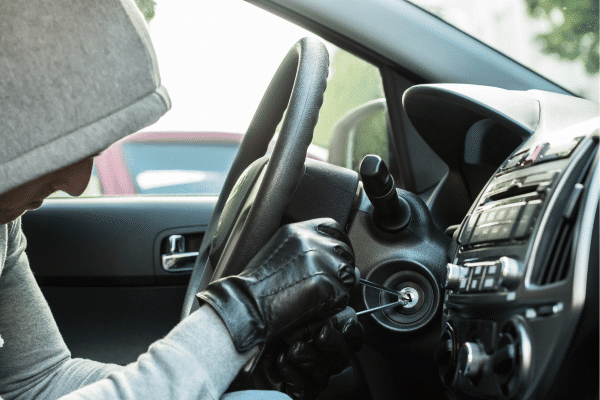
by California Casualty | Auto Insurance Info, Calcas Connection, Good to Know, Helpful Tips |
You’re ready to head home after a night out, but there’s one thing missing: your car. You could have sworn you parked it right here, but it’s no longer there. Vehicle theft can happen anytime, anywhere. When it comes to keeping your car safe, where you park can make all the difference.
Theft by the Numbers
A vehicle is stolen every 32 seconds, according to the National Insurance Crime Bureau. More than a million vehicles are reported stolen each year. California and Colorado have some of the highest number of auto thefts in the country, and of course, urban centers are hotspots for theft. However, thefts happen in the suburbs too, and cars can even be taken from your driveway. In honor of July, National Vehicle Theft Protection Month, we’re taking a look at what you need to know to keep your vehicle safe.
The Worst Places to Park Your Car
Thieves are looking for a chance to steal a car. Don’t give them the opportunity to steal yours. Before you park your car for a short time, or overnight, look around and assess the area for theft potential. Is the area well lit? Are other vehicles parked nearby? Are people around? Is there a security camera or guard? Are there signs of break-ins or damage? All of these can offer clues to an area’s safety.
Avoid empty streets.
Quiet streets and alleyways offer thieves a place to work without interruption. With no one around to witness the theft, they can get in and out quickly with your vehicle.
Avoid poorly lit areas.
Thieves prefer locations where they can work without being seen. Well-lit areas increase their chances of being noticed, while poorly lit and dark locations offer cover.
Avoid high-crime areas.
Do your research before parking in a new place. If the crime rate is high, it’s worth paying for a more secure parking option. High-crime areas aren’t just seedy sections of town. They could be residential neighborhoods that are targeted by thieves.
Avoid empty lots.
You may see lots of cars at office parking lots or at schools. However, when these buildings are not in session, the empty lots provide an easy place for thieves to work. Don’t be tempted to park in an empty lot and put your vehicle at risk.
Avoid remote locations.
Places that are less frequently traveled can be attractive for thieves. Chances are these locations are less often patrolled.
Avoid parking near large vehicles.
Parking your smaller car next to a larger vehicle automatically gives thieves cover. The truck or large car blocks the view so they can work without being easily seen.
How to Protect Your Vehicle
A skilled thief can steal a car in about a minute. However, there are things you can do to make your car seem harder to steal because it will take longer, or they are more likely to get caught.
When parking away from home:
- Park in a garage with security cameras. Park in view of the cameras.
- Be aware of tow truck thieves who come in and tow away your vehicle. When you park, turn your wheel as far to one side as possible. If you have front-wheel drive, park forwards in the spot. For rear wheel drive, back into the spot. This will make it harder to tow your car.
- If you’re parking on the street, choose a busy road where there will be people and other cars the whole time your car will be there.
- Lock your vehicle. The first thing that thieves do is try the doors.
- Hide your valuables out of sight. Even loose change, phone chargers, and other items can tempt thieves to break in.
- Don’t crack your window open on a hot day. An experienced thief can use that to get inside.
- Protect your catalytic converter by etching your VIN onto it.
- Don’t run your car with the keys in it – while you’re somewhere else.
- Keep your registration and insurance in your wallet rather than your glove compartment. That will help prevent the risk of identity theft if your car is stolen.
- Use an anti-theft system. New cars come with one, and you can also add one after market.
When parking at home:
- If you can, park inside your home’s garage. Don’t leave the garage door open. Out of sight is out of mind, and thieves won’t try to steal a car they cannot see.
- Add motion sensor lights to your home and driveway area.
- Don’t leave your key fob in the car. Don’t put it near a door or window inside your home either. Thieves can use the signal to break into your vehicle. Consider keeping keys in a container that doesn’t allow digital signals to pass through.
If your car is stolen, be aware of resources for auto theft victims. Your vehicle is one of your greatest investments. Protect it with the right insurance.
This article is furnished by California Casualty, providing auto and home insurance to educators, law enforcement officers, firefighters, and nurses. Get a quote at 1.866.704.8614 or www.calcas.com.
by California Casualty | Educators, In Your Community, News |
Lewis and Clark Elementary
Local President Melissa Funk, recipient Mckenzie Pollano, and Dee Dee Templeton from California Casualty.
Tenaya Middle School
Music & Arts Grant recipient Nickie Seno and Chris Nieto from California Casualty
Adams City High School
Jason Malmberg – District 14 Classroom Teachers Association President, Brendan Parker – Recipient, Jolie Spence – California Casualty, and Chris Garcia – Principal
Stonecreek Junior High School
Chris Nieto from California Casualty and Music & Arts Grant recipient Kimberly Aguayo
Edith Teter Elementary School
California Casualty Music & Arts Grant recipient Kim Green
Topeka High School
Paula Reilly, Associate Principal; Dustin Dick, Principal; Josh Davis, Grant Recipient; Angela Neuroth, Topeka NEA President; Lindsay Buck, KNEA UniServ Director; Rebecca Stumpf, California Casualty
South Elementary School
Jolie Spence, California Casualty; Jessica Bush, recipient; and Kathey Ruybal, BEA President
Liberty Elementary School
Dee Dee Templeton from California Casualty and Music & Arts Grant recipient Stacy Ryan
Sabin Middle School
Daniel Carragher, Principal (it was pajama day); Megan Langdon and Jessica Medina, recipients; and Jolie Spence, California Casualty
West Putnam Elementary School
Patrisa Espinosa, principal at West Putnam Elementary, and recipient Stephanie Adegbenro
Woodglen Elementary School
Jolie Spence from California Casualty and Music & Arts Grant recipient, Devan Willis
Joli Ann Leichtag Elementary School
California Casualty Music and Arts Grant recipient Lindsey Sparacino
Joe Stefani Elementary School
Jessica Coronado, recipient of the California Casualty Music & Arts Grant
Ella B. Allen Elementary School
Chelice Gilman, California Casualty Music & Arts Grant recipient
Bear Creek K-8 School
Jolie Spence from California Casualty with Music & Arts Grant recipient, Angelina “Crow” Medina
Hugh J. Boyd Jr. Elementary School
Nancy Corsaro, recipient of the California Casualty Music & Arts Grant
Midway Elementary School
Mitzi Hull, recipient of a 2023 Music & Arts Grant from California Casualty
Cheldelin Middle School
Music & Arts Grant recipient, David Blake and Dee Dee Templeton from California Casualty
Koelsch Elementary
Lara Luthy, Boise Education Association president; Marci Greear, Music & Arts Grant recipient; and Layne McInelly, Idaho Education Association president
Owyhee Elementary
Lara Luthy, Boise Education Association president; Charles Diemart, Music & Arts Grant recipient; and Layne McInelly, Idaho Education Association president
Hillside Junior High
Lara Luthy, Boise Education Association president; Emily White, Music & Arts Grant recipient; and Layne McInelly, Idaho Education Association president
Miano Elementary School
Monique Mowad, recipient of a California Casualty Music & Arts Grant
Powell Middle School
Amanda Crosby, LEA President; Mindy Enley, recipient; and Jolie Spence, California Casualty
Diablo Vista Middle School
Chavonta Edington, Music Teacher Ben Loomer, Principal Jeffrey Osbom, and Angie Rajczyk from California Casualty
Olympic High School
Angie Rajczyk from California Casualty with Grant recipient Unjoo Chang, and Principal Courtney Lyou
Mark West Charter School
Angie Rayczyk from California Casualty with Music & Arts Grant recipient Lisa Chapman, and Principal Michelle Franci
Valley Verde Elementary School
California Casualty’s Angie Rajczyk with grant recipient Criag Yen, and Principal Mignon Perkins
Tynes Elementary School
Music & Arts Grant recipient Mary Stuckmeier, APLE President, Linda Manion and Principal, Tonya Gordillo
Barton Elementary School
Principal, Sandy Bartoldus, and Music & Arts Grant recipient, Rosa Guzman
Locke College Prep Academy
Music & Arts Grant recipient, Larry McDuffie with Principal, Peggy Gutierrez
Lindstrom Elementary School
Principal, Dr. Olga Rios, Jana Charles from California Casualty, and grant recipient, Lara Cummins
Madison Elementary School
AVP, Vivian Hanson, Santa Ana USD Trustee, Katelyn Brazer Aceves, Principal, Sara Marin, Grant Recipient, Maria Hollingsworth, (student aide, unknown) and President of SAEA, Sonta Garner-Marcelo

